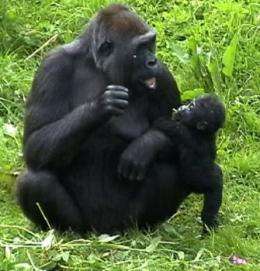Gorillas' right-handedness gives new clues to human language development

(PhysOrg.com) -- A new study that has identified a right-handed dominance in gorillas may also reveal how tool use led to language development in humans.
Psychologist Dr Gillian Forrester, a visiting fellow at the University of Sussex, has been studying a family of gorillas at Port Lympne Wild Animal Park in Kent. Using a specially developed coding system for analysis, she and her team identified which hand gorillas used when doing activities such as: using objects and eating or preparing food (described as 'inanimate targets), and which hand they used for social interactions, such as: scratching their head, patting their friend on the back or mothering ('animate targets').
They found the gorillas were more likely to use their right hands for inanimate targets and either hand with equal frequency - for social interaction. In the human population, 90 per cent are right-handed - and 95 per cent of these right-handers have language centres in the left hemisphere of the brain.
Female gorilla using a stick to extract honey
Dr Forrester's study suggests a direct link between the area of the brain used for manipulating inanimate objects and its specialisation for language skills. She says: 'It is thought that humans exhibit extreme population right-handedness as a sign of our left hemisphere language centers. While a causal relationship is yet to be discovered, this argument for human right-handedness has been bolstered in the past by great ape studies that reveal no consistent population bias for using either hand.'
'These new findings represent a breakthrough in the attempt to define a causal relationship between language and right-handedness,' she adds. 'While apes do not demonstrate language abilities, MRI scans of great apes show that they do share with humans areas designated for language skills in the left hemisphere of the brain. In apes, these areas are active during tool use.'
Video of social interaction (family group)
Dr Forrester says the relationship between right-handedness and language may be due to the repurposing of a brain area once used for structured sequences of events, such as tool use and manufacture, in a common human-ape ancestor. 'The basic hierarchy of steps required to make and use tools could be akin to providing us with the scaffolding to build a syntax for language.'
The study, 'Target animacy influences gorilla handedness', is published this month in Animal Cognition.
Provided by University of Sussex















